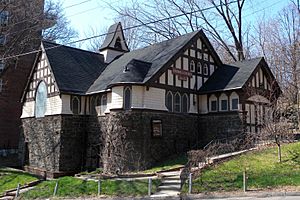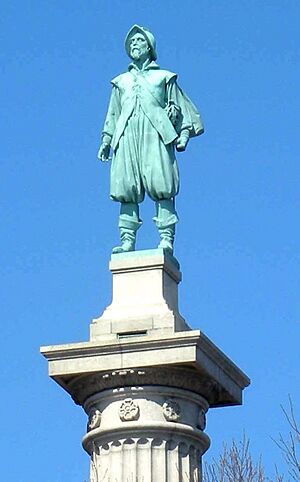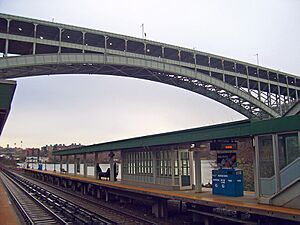Spuyten Duyvil, Bronx facts for kids
Quick facts for kids
Spuyten Duyvil
|
|
|---|---|
|
Neighborhood of the Bronx
|
|

Looking northwest at Edgehill Church of Spuyten Duyvil
|
|
| Country | |
| State | |
| City | |
| Borough | |
| Community District | The Bronx 8 |
| Area | |
| • Total | 1.23 km2 (0.473 sq mi) |
| Population
(2011)
|
|
| • Total | 10,279 |
| • Density | 8,391/km2 (21,732/sq mi) |
| Economics | |
| • Median income | $83,381 |
| ZIP Codes |
10463, 10471
|
| Area code | 718, 347, 929, and 917 |
Spuyten Duyvil is a neighborhood in the Bronx, New York City. It's located where the Harlem River meets the Hudson River. To its north is Riverdale, and to its east is Kingsbridge. Some people think of it as the very southern part of Riverdale.
Contents
- What's in a Name? The Story of Spuyten Duyvil
- A Look Back: Spuyten Duyvil's History
- Who Lives Here? Spuyten Duyvil's People
- Learning and Reading: The Spuyten Duyvil Library
- Getting Around: Transportation in Spuyten Duyvil
- Cool Places to See in Spuyten Duyvil
- Famous People from Spuyten Duyvil
- See also
What's in a Name? The Story of Spuyten Duyvil
- Further information: Spuyten Duyvil Creek#Etymology
The name "Spuyten Duyvil" comes from the nearby Spuyten Duyvil Creek. In Dutch, it can mean "Spouting Devil" or "Spewing Devil." This name likely refers to the strong and wild currents in the water there. It could also mean "Devil's Whirlpool." The word Spui in Dutch is about water outlets.
However, historian Reginald Pelham Bolton thought it meant "spouting meadow." He believed it referred to a fresh-water spring in the area.
A Story from History
A popular story about the name comes from Washington Irving's book, A Knickerbocker's History of New York (1809). The story is set in the 1660s. It tells of a trumpeter named Antony Van Corlear. He was trying to swim across the "Harlean river" (now the Harlem River). He wanted to warn settlers about a British invasion. Irving wrote that Corlear tried to swim "in spite of the devil (spyt den duyvel)." Sadly, the strong current pulled him under, and he drowned. This story helped make the "in spite of the devil" meaning famous for the area.
Experts have studied the name "Spuyten Duyvil" for many years. Most agree that "Duyvil" means "devil." But what "Spuyten" means is still a bit of a mystery.
Long before Europeans arrived, the Lenape Native Americans called the creek Shorakapok. This name meant "the sitting down place" or "the place between the ridges."
A Look Back: Spuyten Duyvil's History
In the late 1600s, Frederick Philipse built a bridge across Spuyten Duyvil Creek. He was allowed to charge people a fee to cross it. This bridge, called "King's Bridge," opened in 1693. It was located near where West 230th Street is today.
The neighborhood started to grow in the late 1800s. This happened when the New York Central and Hudson River Railroad built tracks through the area. At first, the tracks crossed the creek and went into Manhattan on the west side. But Cornelius Vanderbilt wanted all his trains to go to one main station. So, he had new tracks built along the Harlem River. This allowed trains from Albany to connect with other lines and go straight to his new Grand Central Depot in Manhattan. This is still the route used by Metro-North trains today.
Spuyten Duyvil continued to develop through the 1920s. From the 1950s to the 1980s, many large apartment buildings were built. These later became condominiums and co-ops. Many well-off families moved here. They liked the beautiful views and how close it was to nice neighborhoods like Fieldston and Riverdale.
Sadly, there have been train accidents near the Spuyten Duyvil train station. On July 18, 2013, a freight train went off the tracks. No one was hurt in that accident. Less than six months later, on December 1, 2013, a commuter train also derailed. This serious train accident occurred, and sadly, some people were killed and many others were injured. Experts later found that the second accident was caused by the train going too fast.
Who Lives Here? Spuyten Duyvil's People
In 2010, the combined population of Kingsbridge and Spuyten Duyvil was about 30,161 people. This was a small increase from 2000. The area covers about 540 acres.
The people living in these neighborhoods come from many different backgrounds. About 49% were White, 9% African American, and 6% Asian. About 34% of the population was Hispanic or Latino.
The neighborhood is often described as a place where many upper middle class families live.
Learning and Reading: The Spuyten Duyvil Library
The New York Public Library has a branch in Spuyten Duyvil. It's located at 650 West 235th Street. This one-story library opened in 1971. It was designed by an architect named Giorgio Cavaglieri.
Getting Around: Transportation in Spuyten Duyvil
Spuyten Duyvil has its own train station, the Spuyten Duyvil train station. It's part of the Hudson Line of the Metro-North Railroad. You can take trains from here to Grand Central Terminal in Manhattan or north into Westchester County.
The Spuyten Duyvil Bridge is a special railroad bridge that swings open. It carries Amtrak trains between New York City and Albany over Spuyten Duyvil Creek.
The northern end of the Henry Hudson Bridge connects the neighborhood to Manhattan. This bridge is part of the Henry Hudson Parkway.
To help people get to and from the Metro-North station, there's a bus service called Hudson Rail Link. Routes J, K, L, and M serve the Spuyten Duyvil area.
Cool Places to See in Spuyten Duyvil
- Edgehill Church of Spuyten Duyvil This church was built in 1888-89. It has a mix of interesting architectural styles, like Romanesque Revival and Tudor Revival. It was named a New York City landmark in 1980.
- Henry Hudson Park This park has a tall column with a bronze statue of Henry Hudson on top. The statue is 16 feet tall, and the column is 100 feet tall!
- Villa Charlotte Bronte This is an apartment building built in 1926. It has amazing views of both the Hudson and Harlem Rivers.
Famous People from Spuyten Duyvil
- Alexander Calder (1898–1976), a famous sculptor known for his amazing mobiles (moving sculptures).
- William Sergeant Kendall (1869–1938), an artist.
- Georgina Klitgaard (1893–1976), an artist known for her wide landscape paintings.
- Joan Tetzel (1921–1977), an actress.
See also
 In Spanish: Spuyten Duyvil (Bronx) para niños
In Spanish: Spuyten Duyvil (Bronx) para niños



